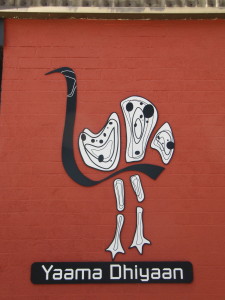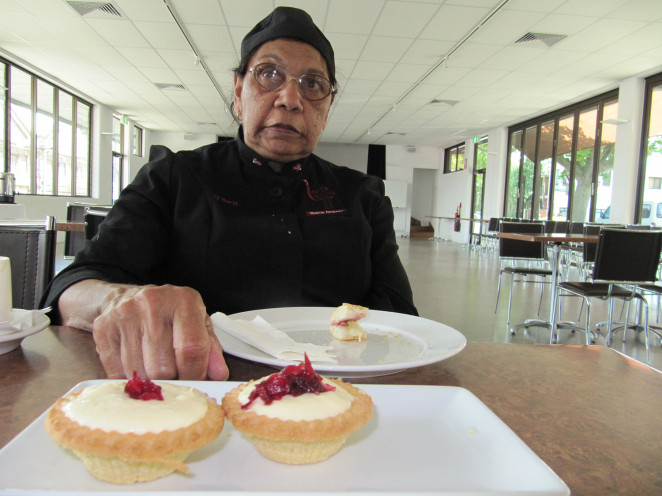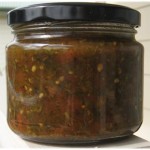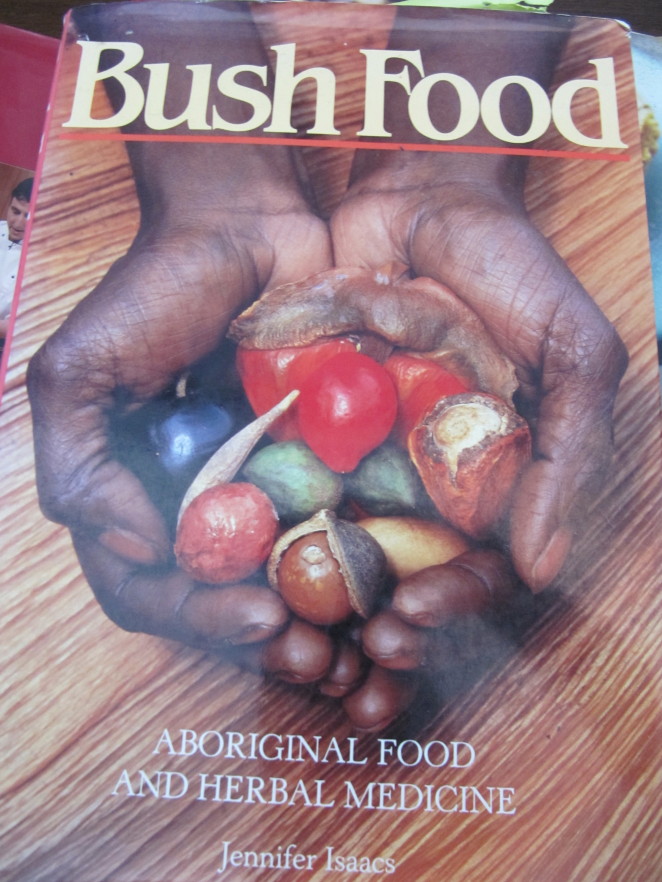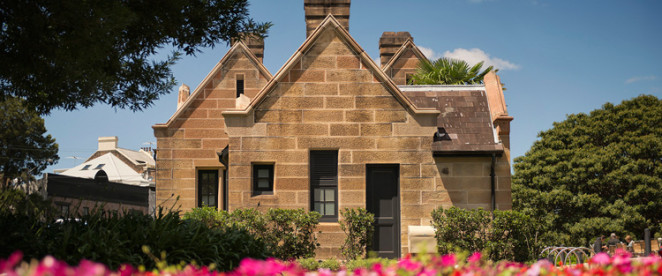[vc_row][vc_column][vc_column_text] [/vc_column_text][/vc_column][/vc_row][vc_row][vc_column width=”1/1″][vc_column_text]
RECIPES | SCHOLARS | MUSIC | EXTRAS | LINKS
[/vc_column_text][/vc_column][/vc_row]
[metaslider id=2794]
Story #7: Hidden Kitchens Australia — Aunty Beryl
[audio: https://kitchensisters.org/audio/Hidden%20Kitchens_Aunty%20Beryl_MIX_061014.mp3]Aunty Beryl Van-Oploo
Aunty Beryl Van-Oploo is an Aboriginal elder who heads Yaama Dhiyaan, the first of its kind cooking and hospitality school for at risk indigenous young people in Australia. The school is housed in the carriage works of an old railroad yard on the neighborhood of Redfern, the heart of the Aboriginal community in Sydney.
“They asked me to name the school,” says Aunty Beryl, “so I thought I might as well say ‘hello’ in my own Yuwaalaraay language. Yaama means ‘hello’ and Dhiyaan means ‘family.’ So it’s ‘Hello family and friends’ when you come here.”
“We have our cappuccino machine here,” says Aunty Beryl leading the way into a spacious light filled room with a modern restaurant size kitchen at one end. “Students practice on the machine here and learn to make cappuccinos, lattes, piccolos, short black and long black.
“A lot of aboriginal people wouldn’t go near a cappuccino machine,” she laughs. “Actually, we don’t drink it. We were never brought up with coffee. It was only just recently. We were tea drinkers.”
From Cappucino to Bushtucker
From how to make a proper cappuccino to how to cook “bush tucker,” (native aboriginal foods), Aunty Beryl is passionate about finding jobs for young people and reconnecting them to their land and long forgotten traditions.
The school takes about twenty students per session. “But we’re lucky if we get twelve to stay,” she says. But the school allows for dropouts.
“Sometimes they can’t cope,” says Aunty Beryl. “When you’re ready you come back. And we’ve had that happen to one of our young lads. He went away for a year and he came back and he said, ‘Aunty Beryl I’m ready to be a chef.”
James Wilden is a student in the eight-week cooking and hospitality course that works to place graduates in restaurants and tourist hotels throughout Australia.
“I’ve been cooking all my life, I’m from the bush,” James says. “I’ve cooked kangaroo, goanna (lizard), yabbies (crustaceans).”
James grew up in a family with fifteen brothers and eight sisters. Times got hard. He and most of his brothers have been in and out of jail all their lives.
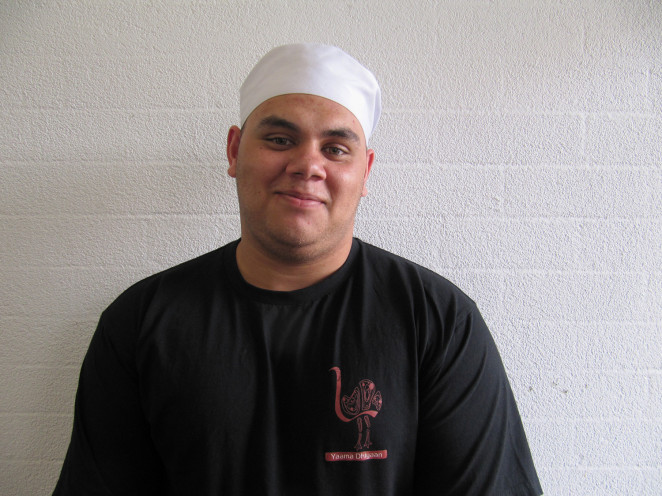
James Wilden was a student in Yaama Dhiyaan’s Hospitality Program. When we met him he was coming to the school every day from jail where he was serving a two and a half year sentence and has since gone begun cooking in the restaurants in the northern territory of Australia.
“When I was younger I made some bad decisions,” says James who is twenty years old. “I’m incarcerated at the moment. I’ll be out in six weeks. That’s why I’m in this course to make my life better.”
“Most of the people in our class are Aboriginal — boys, girls, mothers, fathers, cousins” says twenty-year-old Molly Meribito whose family is from the Bundjalung Tribe from the border of Queensland and New South Wales.
Molly’s mother is long-time friends with Aunty Beryl. “They go way back,” Molly says. “So they were like, you don’t have much to do so you should go and learn with her.”
“I got pregnant young,” she says. “Like I was 16. I didn’t tell anyone until I was seven months pregnant.” Freckle faced with blue eyes, Molly has her son’s name, Heath, named after Heath Ledger, tattooed on her wrist.
CLASSIFIED AS UNEMPLOYABLE
“Traditionally the students that we train are classified as unemployable — that’s what the society has labeled them as,” says Dani Hore who manages the Aboriginal Employment Program that oversees Yaama Dhiyaan.
The Employment Program also offers a carpentry and construction course downstairs from the cooking school. Aunty Beryl’s students prepare lunch each day for themselves and the students studying to be electricians, carpenters and plumbers.
“So many young people don’t even have a home to live in,” Hore says. “One student, who we actually got employment for, was living in a tree. He had nowhere to live and the tree was safe because it was up off the ground.”
The Eveleigh Farmer’s Market
Today Aunty Beryl has brought in a guest speaker. Kylie Kwong, an Australian chef cookbook writer, and television food star who owns Billy Kwong’s restaurant in Sydney is demonstrating how to cook a traditional Chinese stir fry. She chops carrots, celery, asparagus and ginger describing the importance of fresh, organic ingredients and the tricks of slicing and dicing.
Kylie Kwong first met Aunty Beryl at the Eveleigh Farmers Market, held on Saturday mornings near the school. “I came across Aunty Beryl’s stall where she sells Australian native bush tucker produce, jams and marmalade,” says Kwong. “ She’s got beautiful big hands and long fingers. She’s really elegant. She’s just got this lovely warmth and wisdom.”
The two women have become friends working together experimenting with the bush flavors in cooking.
“I think it’s good mix,” says Aunty Beryl, “because Asian people and Chinese people have this taste which is similar to the Aboriginal people. It’s sweet and sour. I think the blend will be really great.”
BUSH TUCKER
“Bush tucker, is what we got off the land, and that is why we are introducing it again, connecting students to their culture through food,” says Aunty Beryl. Many Australian are experimenting with bush tucker food and flavors. working to re-introduce native bush tucker food into the culture.
“You have your fruits, nuts, yams,” Aunty Beryl lists off. “You have your meats –kangaroo, wallaby, wild buffalos up North. She describes lemon myrtle, quandongs (an indigenous peach), marigold (a native spinach) and salt bush, a familiar shrub over large areas of dry inland Australia.
“Saltbush is becoming very popular,” says Aunty Beryl. “It’s a natural salt. Now they’re feeding their lamb salt bush, so you can get salt bush lamb which is quite healthy.”
“You have your seafood like barramundi It’s got a real bushy sort of flavor. It’s got that woody, tart flavor. Wrap it in gum leaves and throw it on an open fire. Then it will cook in it’s own oils.”
“We do wattle seed muffins– wattle seed comes off the Acadia tree. You have to steep it first, and then you get that brittle chocolaty, caramely flavor. In Southern Australia and the territory we’re starting to grow bush tomatoes where ever we can.”
“I’m going into farming with my friend, this is another venture, we just planted another lime tress on her property. So we’ll become this supplier.”
“You can have Kangaroo with stir-fry, kangaroo stuffed with mushrooms. Getting kangaroo is like having a piece of steak over here, in New South Wales. They have kangaroo in south Aus as part of their main meal every day, because people buy it. We are just starting to introduce it in the butcher shops now.
“A finger lime is shaped like your finger, I call it the Aboriginal caviar because when you split it and open it up it’s got little lime modules inside, and they are really great on fresh oysters rare, and you just put them on and it does look like caviar. With the finger limes, anything can happen. I’m just about to experiment we are going to make some finger lime gelato.”
Kangaroo stir-fry, kangaroo filet, you can stuff it with mushrooms. We also have emu proscuitto now, so we’re getting really clever.
You can’t eat your totem
Aunty Beryl talks about emu prosciutto, but she doesn’t eat the ostrich-like bird that some say tastes like steak.
“My totem is an emu, so I don’t eat it,” she says. It’s an animal that we worship.” A totem is a being, an animal or plant, that serves as an sacred symbol to an aboriginal clan or tribe. A totem connects people ancestors and mythic past.
“Kangaroo, goanna, dolphins, whatever totem your aboriginal tribe has you can’t kill touch or eat,” says student James Willden. “I’m an emu. If I kill an emu, it’s like killing my brother, my sister, or my mother.”
“You can’t eat your totem,” says seventeen-year old Ricardo Golding. “My totem is a turtle. My tribe name is Gumbangi.”
Ricardo has come to Yaama Dhiyaan just out of high school. “I had nothing to do,” he says. “I’m not that smart, but I’m doing my work. I used to get picked on a lot at school, because of the sound of my voice. The way I act. I was very afraid to go into class. I missed out on a lot of lessons. Here, the cooking is the part I like the most.”
The biggest thing is self confidence
“The biggest thing our students or anybody has to deal with,” says Aunty Beryl, “ is their self confidence and that they can do it.
Aunty Beryl is from the Gamillera tribe and grew up on a reservation in New South Wales about five hundred miles from Sydney. “When I grew up it was limited. My mum died when I was fourteen years of age. My aunt had seven of her own children, didn’t want to separate us. So there were seventeen of us. all in a shack, four in a bed.
“My eldies told me to learn to read and write. And I did. I came to Sydney when I was 16 and got a job as a nanny. I finally got an education at the age 31 years of age.
The Stolen Generation
The history of the treatment of native cultures in Australia is a dark one, whole generations of children taken away from their parents, forced into missionary schools, native language forbidden, traditional foods taken away, whole clans forced off their own lands and on to reservations, cultures denied the right to vote until the 1960s.
Jamie Rayburch works with Aunty Beryl helping out with the hospitality and training program. “My grandfather was part of The Stolen generation. He was stolen away when he was five years old and put into a cattle ranch and then into an all boys orphanage. He never knew his parents. My grandmother’s the same. She grew up in a mission with her mother. Her father was taken away and they didn’t know anything about their culture.
“I’m 24 years old,” says Jamie, “ and I’m still trying to understand what that’s all about and how that effected my family, my culture, myself. I think that this generation, the Stolen Generation has kind of almost been forgotten, where our culture came from, where the food derives from as well.”
Dani Hore took a break from her work running Yaama’s Employment Program to talk to us about these issues. “The Stolen Generation” is part of Australia’s history. As part of government policy, Aboriginal children were removed from their parents, and that impact is still being felt today.
Because we are talking about of the equivalent of our grandparents and in some cases our parents who were removed from their families and taken and put in welfare institutions or put in very vulnerable positions, especially the girls in people’s homes and the consequence of that is that there is a generational issue around family.”
“From the day the first ships arrived,” says Dani Hore, “the foreigners brought with enormous challenges to the country. People lived in tolerance of each other until peoples’ resources were threatened. The Aboriginals’ resources were threatened when they were taken over by farmers. And their resources were threatened when aboriginal people came to get some of the harvest or kill a beast. You just had a cultural clash. But like all humans everybody was just trying to eat.”
Once these young people come to Yaama Dhiyaan, continues Dani, they know that they are in a caring loving, environment where they are going to be taught vocational skills. But they are also going to be taught about self respect and self esteem and life skills that a parent would normally teach about punctuality and cleanliness and you know, how to talk to people, how to eat together- so it’s a very short period of time but it’s quite transformational.”
Aboriginal people did not get the vote in Australia until the 1960s, and their status as members of the community was rather negligent. “Not very long when you think about it,”says Dani, so I think, what this country is dealing with is really the repercussions of that, so it’s really important that Aboriginal people have got the opportunity to get an education and get work.
And I guess what we say is that this is a very good model because it’s an Aboriginal environment, it’s culturally appropriate, and the trainers are Aboriginal, the managers and mentors are Aboriginal, so it’s always presenting a fabulous role model.”
It’s James’ journey now
Along with learning to make lemon myrtle rose tarts, the perfect long black coffee, emu prosciutto, and how to card people and look for fake id’s when someone walks into a bar to make sure they are over 21, all skills required in Australia’s hospitality and cooking industry, Yaama Dhiyaan is providing a vision for a future, and a sense of community.
James Wilden is preparing to graduate from his program in the next weeks. “I just love cooking,” James tells us.” “I love the smell. When I get out and get out of trouble I want to be a chef.” James is eager to start his work, but tears up at the thought of leaving the deep community of this Australian hidden kitchen.
Before he gets too broken up, Aunty Beryl speaks for her school. “We’re looking at James going up into the northern territory and becoming an apprentice chef up there. I know James will be a success because his heart is in it. At the end of the day, it’s James’ journey now, once he leaves here. But, we’re only a phone call away because that’s what Yaama’s all about that. We’re always going to be there as part of his journey.”
Back to top [vc_column width=”1/1″][/vc_column][vc_column_text][/vc_column_text][symple_divider style=”solid” margin_top=”20px” margin_bottom=”20px”]
Aunty Beryl Recipes
[symple_tabgroup] [symple_tab title=”Bush Tomato Relish“]
Bush Tomato Relish
Recipe from Bush Tucker Recipes
Ingredients:
8 large truss tomatoes
¾ cup white sugar
1 cup white vinegar
1 dessert spoon Native Basil
1 ½ dessert spoons CrushedBush Tomato (Kutjera)
2 dessert spoons Saltbush
1 dessert spoon Mountain Pepper (also known as Dorrigo Pepper)
1 dessert spoon Sea Parsley
2 teaspoons salt
½ cup finely diced brown onion
½ cup finely diced green capsicum
Core the tomatoes and make a small cross incision at the base of each. Place into a saucepan of boiling water for 40 seconds to blanch. Remove with a slotted spoon and plunge immediately into iced water.
When cool, peel tomatoes, cut in half, remove seeds and finely dice.
Place sugar and vinegar in a large saucepan over a high heat. Add native herbs and stir until sugar has dissolved. Add chopped tomatoes, onion and green pepper. Bring to the boil, reduce heat to low and simmer for 20 minutes or until the liquid has reduced and relish becomes sticky. Season with salt and pepper to taste.
[/symple_tab]
[symple_tab title=”Kangaroo Pie“]
Kangaroo, lentil and sweet potato cottage pie
Recipe from Taste.com.au
Preparation Time: 30 minutes | Cooking Time: 90 minutes | Serves: 4
Ingredients:
500g kangaroo mince
1 medium onion diced
1 medium carrot diced
1 cup celery leaf chopped
1 tsp crushed garlic
1 tbs mixed dried herbs
1 tsp Dijon mustard
2 tbs Worcestershire sauce
2 slice pancetta or bacon diced
2 large tsp tomato paste
2 large tbs home-made tomato sauce (Healthy store bought is fine)
1 tin brown lentils, rinsed and drained
1/4 cup water or stock
2 sweet potatoes
1 tbs butter (preferably organic or grass fed)
1/2 cup Parmigiano-Reggiano finely grated (or parmesan)
1. Heat a medium pot to high heat then add the kangaroo mince, keep stirring the mince until it is all browned and releases from the bottom of the pot then add the diced pancetta or bacon, onion, carrot and celery leaf and cook on medium for 5 minutes or until soft the add garlic, herbs and cook for another 2 minutes whilst stirring it in so that it doesn’t catch on the bottom of the pot. Add the remaining ingredients; stir them in the cook on low for ¾ hr
2. In another pot at the peeled and sliced sweet potato, add enough water to just cover and boil on medium until soft, drain the water then return to the stove to evaporate the traces of water whilse adding the butter and Parmigiano-Reggiano (parmesan cheese) then blend with a stick blender until smooth and creamy.
3. Spoon the mince/lentil mixture into a pie dish and level it with a spoon. Add the mashed sweet potato to a piping bag and pipe onto the top of the mince the grate or zest some more Parmigiano-Reggiano over the potato and bake on 150 degrees celcius for half an hour or until crispy on top. Serve with a salad or steamed broccoli and enjoy!
[/symple_tab]
[symple_tab title=”Ginger-Pickled Cucumbers“]
Ginger-Pickled Cucumbers
Serves 4 as a side dish | Recipe from Kylie Kwong’s It Tastes Better
Ingredients
5 small cucumbers, peeled
2 teaspoons salt flakes
2 tablespoons peanut oil
5 cm piece ginger, finely diced
2 cloves garlic, finely diced
2 tablespoons brown sugar
3 tablespoons brown rice vinegar
1 long red chili, cut in half lengthways, deseeded and finely diced
Sichuan pepper and salt
Cut cucumber in half lengthways and scoop out the seeds using a spoon. Place cut-side down on a chopping board and cut on the diagonal into 1 cm slices. Place cucumber in a bowl, sprinkle with salt and mix well. Cover and refrigerate for 30 minutes. Drain cucumbers and, using your hands, gently squeeze out any excess liquid.
Heat oil in a small saucepan, add ginger and garlic and fry gently for 1 minute or until fragrant. Add sugar and vinegar, bring to the boil and cook for about 3 minutes or until the syrup is slightly reduced, then add chilies and remove from heat.
Combine cucumber with ginger and chili syrup and leave to stand for 30 minutes.
Arrange cucumber on a serving plate. Season with Sichuan pepper and salt and serve.
[/symple_tab] [/symple_tabgroup]
Key Ingredients in Bush Tucker Food
FRUITS
- Kutjera – looks like a raisin, is rich in vitamin C and tastes like strong caramel
- Muntries – also known as emu apples or native cranberries. These taste like spicy apple
- Riberry – a coastal rainforest tree with its fruit tasting like tart cranberries with a hint of clove
- Quandong – from the sandalwood family and is rather like a peach with a waxy skin. Ripens in summer
- Davidson’s plum – 3 rainforest plant species with a rather sour fruit that resembles a traditional plum. Renowned as being a gourmet bush tucker fruit
- Finger lime – now popular in gourmet Australian marmalade, this fruit has a very zesty flavour
VEGETABLES
- Warrigal greens – a bit like spinach and seeds were shipped back to Great Britain with Captain Cook to help fight scurvy.
- Bungwall Fern – the roots were soaked, roasted and then ground to make flour
SPICES
- Lemon myrtle – used in cooking and as a healing plant. It has a high content of Citral which is used to keep mosquitoes at bay.
- Mountain pepper a peppery plant used to flavour cuisine
- Aniseed myrtle – a great aniseed flavour now used in essential oils
NUTS
- Bunya Nut – From the Bunya tree, sacred to the aboriginals. The nuts are like pine nuts and can be eaten as is or ground up to make bread
- Macadamia Nut – a nut high in good fats and also great for the skin when in an essential oil. Now mass produced throughout Australia
Back to top [symple_divider style=”solid” margin_top=”20px” margin_bottom=”20px”]
Humanists & Scholars
Back to top [symple_divider style=”solid” margin_top=”20px” margin_bottom=”20px”]
Music
Songs from Aunty Beryl
Extras
Gardeners Lodge Cafe
[symple_divider style=”solid” margin_top=”20px” margin_bottom=”20px”]
Links
 |
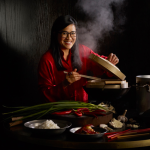 |
 |
||
| Eveleigh Farmer’s Market | Kylie Kwong | Royal Botanic Gardens |


